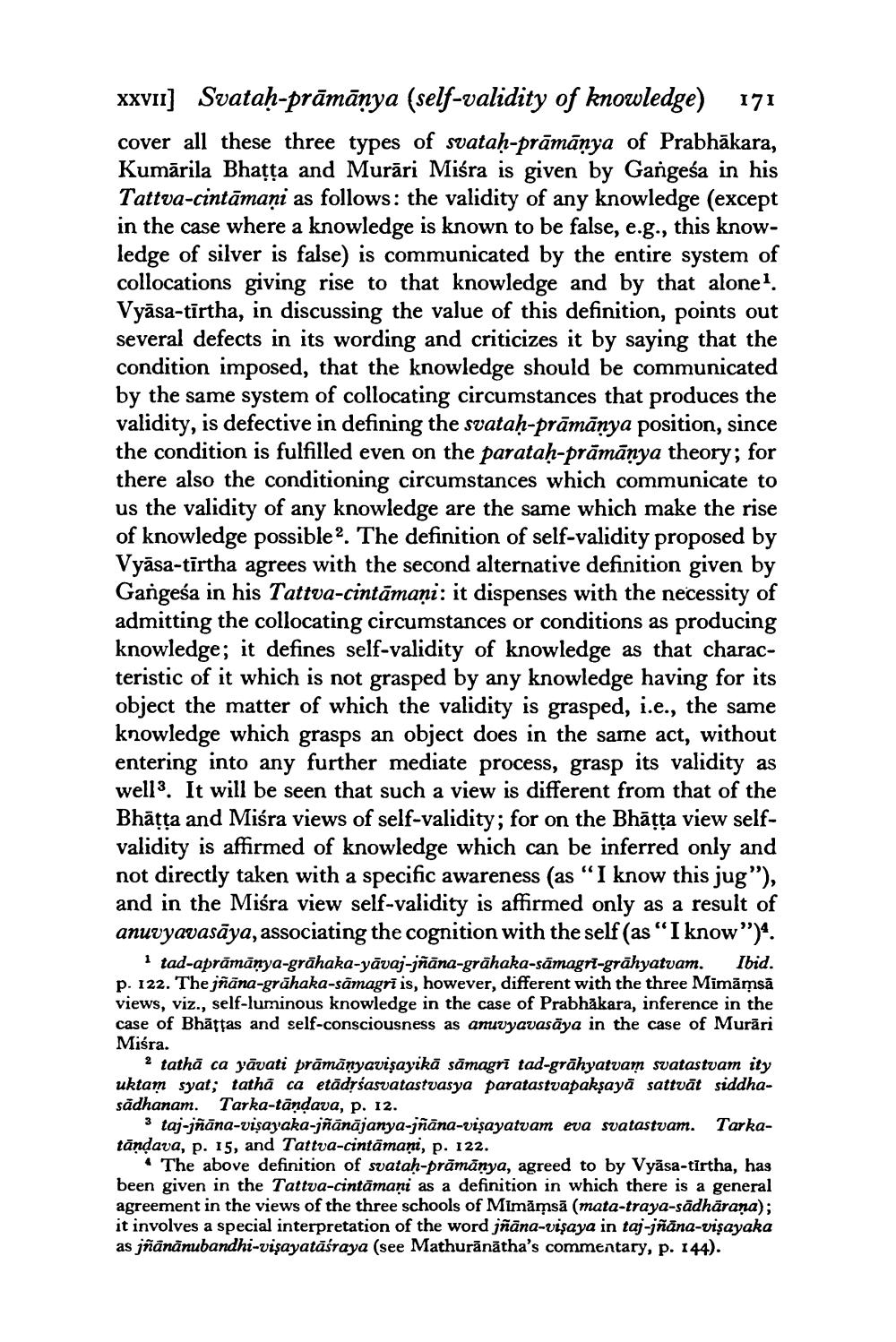________________
XXVII] Svataḥ-prāmānya (self-validity of knowledge) 171 cover all these three types of svataḥ-prāmānya of Prabhākara, Kumārila Bhatta and Murāri Miśra is given by Gangeśa in his Tattva-cintāmaņi as follows: the validity of any knowledge (except in the case where a knowledge is known to be false, e.g., this knowledge of silver is false) is communicated by the entire system of collocations giving rise to that knowledge and by that alone Vyāsa-tirtha, in discussing the value of this definition, points out several defects in its wording and criticizes it by saying that the condition imposed, that the knowledge should be communicated by the same system of collocating circumstances that produces the validity, is defective in defining the svatah-prāmānya position, since the condition is fulfilled even on the parataḥ-prāmānya theory; for there also the conditioning circumstances which communicate to us the validity of any knowledge are the same which make the rise of knowledge possible. The definition of self-validity proposed by Vyāsa-tīrtha agrees with the second alternative definition given by Gangesa in his Tattva-cintamani: it dispenses with the necessity of admitting the collocating circumstances or conditions as producing knowledge; it defines self-validity of knowledge as that characteristic of it which is not grasped by any knowledge having for its object the matter of which the validity is grasped, i.e., the same knowledge which grasps an object does in the same act, without entering into any further mediate process, grasp its validity as well3. It will be seen that such a view is different from that of the Bhāțta and Miśra views of self-validity; for on the Bhāțta view selfvalidity is affirmed of knowledge which can be inferred only and not directly taken with a specific awareness (as "I know this jug”), and in the Miśra view self-validity is affirmed only as a result of anuvyavasāya, associating the cognition with the self (as "I know")*.
tad-aprāmānya-grāhaka-yāvaj-jñāna-grāhaka-samagri-grāhyatvam. Ibid. p. 122. The jñāna-grāhaka-sāmagri is, however, different with the three Mimāmsā views, viz., self-luminous knowledge in the case of Prabhakara, inference in the case of Bhāffas and self-consciousness as anuvyavasāya in the case of Murāri Miśra.
2 tathā ca yāvati prāmānyavişayikā sāmagri tad-grāhyatvam svatastvam ity uktam syat; tathā ca etādrśasvatastvasya paratastvapakşayā sattvāt siddhasādhanam. Tarka-tandava, p. 12.
3 taj-jñāna-visayaka-jñānājanya-jñāna-visayatvam eva svatastvam. Tarkatāndava, p. 15, and Tattva-cintamani, p. 122.
• The above definition of svatah-prāmánya, agreed to by Vyåsa-tirtha, has been given in the Tattva-cintamani as a definition in which there is a general agreement in the views of the three schools of Mimāmsā (mata-traya-sādhārana); it involves a special interpretation of the word jñāna-visaya in taj-jñāna-visayaka as jñānānubandhi-vişayatāśraya (see Mathurānātha's commentary, p. 144).




